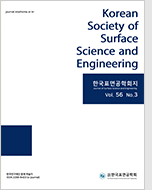
- Past Issues
- e-Submission
-

2021 Impact Factor 1.766
5-Year Impact Factor 1.674
Editorial Office
- +82-2-563-0935
- +82-2-558-2230
- submission@kssse.or.kr
- https://www.kssse.or.kr/

2021 Impact Factor 1.766
5-Year Impact Factor 1.674
The Korean Society of Surface Science and Engineering 2024;57(6):449-455. Published online: Dec, 31, 2024
DOI : 10.5695/JSSE.2024.57.6.449
In conventional catalyst supports for fuel cell membrane electrode assemblies (MEA), carbon-based materials such as activated carbon, carbon nanotubes, and graphene are commonly used to enhance the performance of platinum catalysts. However, their reliance on fossil resources raises environmental concerns. In this study, we explored an alternative approach by producing carbon fillets, functioning as catalyst supports, from jellyfish, considered marine waste, and seaweed roots, a byproduct of fishery processing. Six different samples were fabricated under varying conditions and characterized using Brunauer–Emmett–Teller specific surface area analysis, X-ray diffraction, X-ray photoelectron spectroscopy, and organic elemental analysis. Among them, the seaweed-derived sample, activated with C: KOH at a ratio of 1:1 demonstrated the best performance with a high surface area of 1360 m²/g and no detectable impurities. Consequently, the MEA catalyst support developed in this study shows promising potential for future applications in sustainable fuel cell technologies.
Keywords Jellyfish; seaweed root; catalyst support; membrane electrode assembly; fuel cell